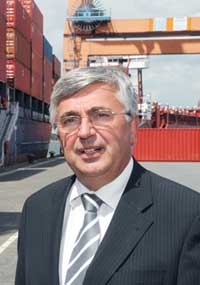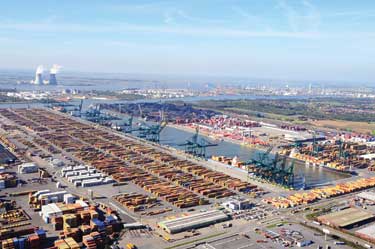By Leo Ryan, AJOTAmong the northern European ports on the Le Havre-Hamburg range, Antwerp has in recent years become a bigger factor on various world trade lanes and is now going after the significant markets opening up for the new generation of mega-containerships thanks in particular to a marked deepening of channels on the Scheldt River. This would involve cutting into the current dominance of Rotterdam in the Far East container trades.
This, in essence, was the key message transmitted by Eddy Bruyninckx, CEO of the Antwerp Port Authority, during an interview while passing through Montreal on a North American mission that also took his port delegation to Chicago and the Breakbulk Americas trade fair in Houston (Oct. 9-11).
His overall resolutely-optimistic belief was summed up in the term: “Yes, we can!”
 Eddy Bruyninckx – CEO of the Antwerp Port Authority
Eddy Bruyninckx – CEO of the Antwerp Port Authority
The second largest European port after Rotterdam, Antwerp is the leading European gateway in the North Atlantic container trade with the United States and Canada, holding a 36% market share versus 26% for Bremen and 21% for Rotterdam.
The United States is Antwerp’s biggest overseas trading partner, through some 20 million tonnes of freight annually. Canada comes in at just under 5 million tonnes. In both cases, the emphasis is on containers.
Among other foreign markets on the container front, Antwerp also claims to be the leader with Africa, the Middle East, Central America, South America and India.
All told, Antwerp handled 187 million tonnes in 2011, a 5% increase over the previous year. Container cargo alone accounted for 105 million tonnes. Liquid bulk was 46 million tonnes, dry bulk 19 million tonnes, breakbulk 12.7 million tonnes, and ro/ro 4.2 million tonnes. Some 15,240 seagoing ships visited the port. The substantial barge traffic totaled 87 million tonnes.
Situated 80 kilometres (50 miles) inland from the North Sea, Antwerp enjoys an exceptionally central location – with its docks (including eight box terminals) connected to a rich hinterland by rail, road and waterway.
 Aerial view of the Port of Antwerp
Aerial view of the Port of Antwerp
In the first six months of 2012, Antwerp saw its total throughput decline by 2.1% to 93.8 million tonnes. This was mainly attributed to the suspension of operations of Belgian Refining Corporation.
But container volume rose slightly. The total numbers appeared to suggest that Antwerp among North European ports was weathering the recent negative economic trends in Europe comparatively well. In this regard, Global Port Tracker, published by Hackett Associates and the Bremen-based Institute of Shipping Economics, said that Antwerp could be expected to remain “relatively stable with some growth” whereas Rotterdam could be hit hard as a result of its heavy dependence on the Far East.
Big shift favouring container cargoLooking at the evolution of Antwerp port traffic in the past few decades, there has been a significant shift to containers.
“When I started with the port 20 years ago, container cargo was just 25%,” recalled Bruyninckx. “Today it represents 56%.”
“In the past two decades, we have been really focused on the improvement of the maritime access to the port, “ he said. “Our prime concern was to attract the biggest container vessels.”
At one point, in the mid-1990s, some observers had referred to Zeebrugge as the future container option in Flanders. It was there that CAST container line (later absorbed by CP Ships and subsequently by Hapag-Lloyd) chose to launch a service.
But the deepening of the channels on the Scheldt River has been a game-changer. Since early 2011, containerships with capacities of more than 10,000 TEUs and a draught of up to 16 metres (53 feet) have been able to call Antwerp. The record thus far has been set by the
Edith Maers
 Eddy Bruyninckx – CEO of the Antwerp Port Authority
Eddy Bruyninckx – CEO of the Antwerp Port Authority
 Aerial view of the Port of Antwerp
Aerial view of the Port of Antwerp
 Eddy Bruyninckx – CEO of the Antwerp Port Authority
Eddy Bruyninckx – CEO of the Antwerp Port Authority
 Aerial view of the Port of Antwerp
Aerial view of the Port of Antwerp